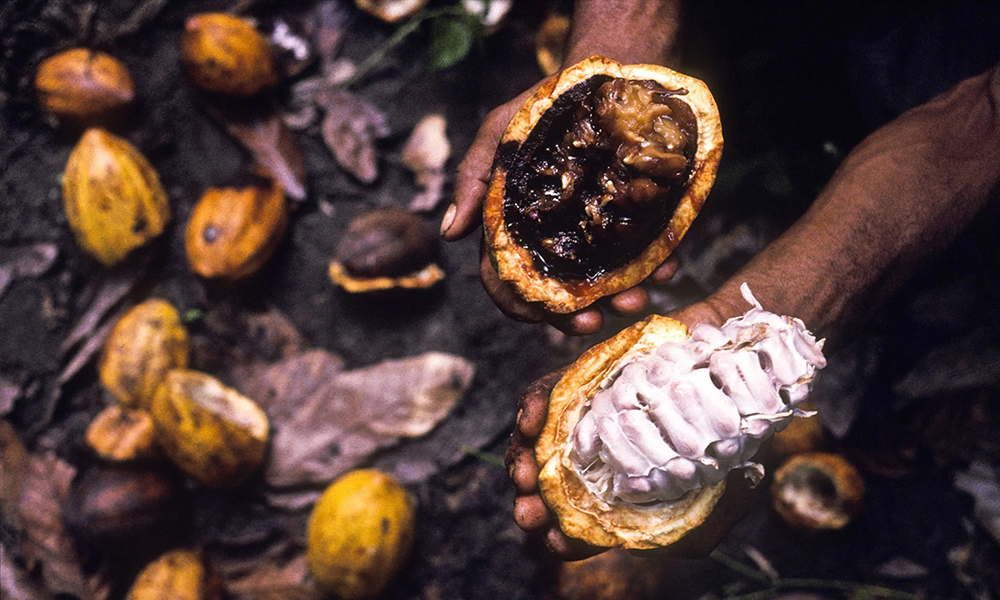
在HBO热播剧《最后生还者》(The Last of Us)的开场,一位流行病学家告诉持怀疑态度的脱口秀观众,大自然对人类最大的威胁之一不是病毒引起的大流行,而是全球变暖导致的寄生真菌进化(这一趋势不可阻挡),将人类宿主变成了威胁社会的无脑生物。
值得庆幸的是,僵尸爆发这样的假设仍然是小说题材,但科学家警告说,尽管真菌病原体不太可能伤害人类,但病毒的广泛传播仍然对我们的粮食系统构成严重威胁。
根据5月2日发表在《自然》杂志(Nature)上的一份由粮食安全和真菌病原体专家撰写的报告,由于气候变化,世界上许多最重要的农作物都面临真菌感染日益盛行的风险。作者写道,真菌对“人类健康构成重大威胁”,因为真菌爆发已经导致农民每年在种植时损失10%至23%的作物,收获后又损失10%至20%。
真菌病原体一直对农作物构成重大威胁,因为它们寿命长,而且极易传播。但由于高纬度地区气温升高,真菌爆发变得越来越频繁,这使得通常存在于热带地区的真菌传播速度比以往任何时候都要快,就像电视剧中出现的那场终结世界的真菌爆发一样。
该报告的合著者之一、埃克塞特大学(University of Exeter)的粮食安全系主任萨拉·古尔在一份声明里写道:“虽然这一故事情节是科幻小说,但我们警告,随着全球变暖,真菌的耐药性增强,我们可能会看到一场由真菌感染在全球迅速蔓延造成的全球健康灾难。”
“迫在眉睫的威胁不是僵尸,而是全球饥荒。”
一场“完美风暴”
美国农业部(U.S. Department of Agriculture)指出,真菌感染导致在收割开始之前损失高达20%的作物,代价高昂,全球每年可能损失高达2,000亿美元。据研究人员称,每年真菌感染造成的粮食损失相当于满足多达40亿人日常热量需求所需的粮食量。
报告指出,世界上最重要的五种热量作物是水稻、小麦、玉米、大豆和土豆,它们都容易受到真菌病害的影响。仅大米、小麦和玉米就能够提供人体超过40%的热量。
真菌已经很危险了,因为它们可以随风传播很远的距离,并迅速吞噬大片农作物,但一些现代问题造成“完美风暴”威胁,使危机加剧。
该报告表示,杀菌剂的广泛使用正在导致真菌耐药性增强,而单一种植的日益普及促使真菌迅速吞噬单一作物。气候变化可能是导致情况恶化的最主要因素,因为真菌目前正在以每年约7公里(超过4英里)的速度向两极地区推进。例如,小麦秆锈病是一种通常在埃塞俄比亚等热带国家出现的病原体引起的病害,但多年来在包括英国和斯堪的纳维亚国家在内的高纬度地区也观察到该病原体引起的病害。
所有这些因素加起来,都让真菌病原体更易传播,并对农作物造成严重破坏,在最糟糕的时候会带来全球健康灾难威胁。
到2050年,世界人口将达到近100亿,对粮食的需求增加,其中大部分增长来自资源紧张的非洲国家。特别是撒哈拉以南非洲的粮食不安全状况正在加剧,因为气候变化、持续干旱和俄乌冲突破坏了该地区的粮食供应。2020年,非洲超过五分之一的人口面临长期饥饿。
“预计全球人口将飙升,人类正面临前所未有的粮食生产挑战。我们已经发现,真菌感染导致农作物大量损失,而损失的作物每年足以养活数百万人。”该报告的另一位合著者、德国基尔大学(Christian-Albrechts University of Kiel)的真菌和群体遗传学教授伊娃·斯图肯布洛克说。
阻止传播
该报告呼吁研究人员提高对真菌感染危害的“认识”。古尔称,虽然《最后生还者》已经引起了人们对真菌威胁的关注,但要避免一场重大的健康危机,可能还需要更多的关注。
除了为研发有效的杀菌剂提供更多资金外,该报告还呼吁农民和政府加强合作,增加作物多样性,以减缓真菌病原体的传播。作者还号召对抗病作物以及早期疾病检测(通过人工智能和遥感技术实现)进行更多研究。
该报告主张建立一个全球机构,协调和指导保护作物免受感染的相关工作,就像各国政府和学术界在新冠疫情期间集中资金和资源研究病毒感染和预防一样。
就像HBO电视剧开头虚构的流行病学家一样,研究人员认为,真菌病原体研究应该和病毒研究一样受到重视,并获得资源支持,因为其风险可能同样较高。
古尔说:“我们看到世界各国因为新冠疫情造成的人类健康威胁而团结起来。”他呼吁各国在真菌感染方面加大投资,“阻止真菌爆发发展成一场全球灾难,使人们陷入饥荒。”(财富中文网)
译者:中慧言-王芳
在HBO热播剧《最后生还者》(The Last of Us)的开场,一位流行病学家告诉持怀疑态度的脱口秀观众,大自然对人类最大的威胁之一不是病毒引起的大流行,而是全球变暖导致的寄生真菌进化(这一趋势不可阻挡),将人类宿主变成了威胁社会的无脑生物。
值得庆幸的是,僵尸爆发这样的假设仍然是小说题材,但科学家警告说,尽管真菌病原体不太可能伤害人类,但病毒的广泛传播仍然对我们的粮食系统构成严重威胁。
根据5月2日发表在《自然》杂志(Nature)上的一份由粮食安全和真菌病原体专家撰写的报告,由于气候变化,世界上许多最重要的农作物都面临真菌感染日益盛行的风险。作者写道,真菌对“人类健康构成重大威胁”,因为真菌爆发已经导致农民每年在种植时损失10%至23%的作物,收获后又损失10%至20%。
真菌病原体一直对农作物构成重大威胁,因为它们寿命长,而且极易传播。但由于高纬度地区气温升高,真菌爆发变得越来越频繁,这使得通常存在于热带地区的真菌传播速度比以往任何时候都要快,就像电视剧中出现的那场终结世界的真菌爆发一样。
该报告的合著者之一、埃克塞特大学(University of Exeter)的粮食安全系主任萨拉·古尔在一份声明里写道:“虽然这一故事情节是科幻小说,但我们警告,随着全球变暖,真菌的耐药性增强,我们可能会看到一场由真菌感染在全球迅速蔓延造成的全球健康灾难。”
“迫在眉睫的威胁不是僵尸,而是全球饥荒。”
一场“完美风暴”
美国农业部(U.S. Department of Agriculture)指出,真菌感染导致在收割开始之前损失高达20%的作物,代价高昂,全球每年可能损失高达2,000亿美元。据研究人员称,每年真菌感染造成的粮食损失相当于满足多达40亿人日常热量需求所需的粮食量。
报告指出,世界上最重要的五种热量作物是水稻、小麦、玉米、大豆和土豆,它们都容易受到真菌病害的影响。仅大米、小麦和玉米就能够提供人体超过40%的热量。
真菌已经很危险了,因为它们可以随风传播很远的距离,并迅速吞噬大片农作物,但一些现代问题造成“完美风暴”威胁,使危机加剧。
该报告表示,杀菌剂的广泛使用正在导致真菌耐药性增强,而单一种植的日益普及促使真菌迅速吞噬单一作物。气候变化可能是导致情况恶化的最主要因素,因为真菌目前正在以每年约7公里(超过4英里)的速度向两极地区推进。例如,小麦秆锈病是一种通常在埃塞俄比亚等热带国家出现的病原体引起的病害,但多年来在包括英国和斯堪的纳维亚国家在内的高纬度地区也观察到该病原体引起的病害。
所有这些因素加起来,都让真菌病原体更易传播,并对农作物造成严重破坏,在最糟糕的时候会带来全球健康灾难威胁。
到2050年,世界人口将达到近100亿,对粮食的需求增加,其中大部分增长来自资源紧张的非洲国家。特别是撒哈拉以南非洲的粮食不安全状况正在加剧,因为气候变化、持续干旱和俄乌冲突破坏了该地区的粮食供应。2020年,非洲超过五分之一的人口面临长期饥饿。
“预计全球人口将飙升,人类正面临前所未有的粮食生产挑战。我们已经发现,真菌感染导致农作物大量损失,而损失的作物每年足以养活数百万人。”该报告的另一位合著者、德国基尔大学(Christian-Albrechts University of Kiel)的真菌和群体遗传学教授伊娃·斯图肯布洛克说。
阻止传播
该报告呼吁研究人员提高对真菌感染危害的“认识”。古尔称,虽然《最后生还者》已经引起了人们对真菌威胁的关注,但要避免一场重大的健康危机,可能还需要更多的关注。
除了为研发有效的杀菌剂提供更多资金外,该报告还呼吁农民和政府加强合作,增加作物多样性,以减缓真菌病原体的传播。作者还号召对抗病作物以及早期疾病检测(通过人工智能和遥感技术实现)进行更多研究。
该报告主张建立一个全球机构,协调和指导保护作物免受感染的相关工作,就像各国政府和学术界在新冠疫情期间集中资金和资源研究病毒感染和预防一样。
就像HBO电视剧开头虚构的流行病学家一样,研究人员认为,真菌病原体研究应该和病毒研究一样受到重视,并获得资源支持,因为其风险可能同样较高。
古尔说:“我们看到世界各国因为新冠疫情造成的人类健康威胁而团结起来。”他呼吁各国在真菌感染方面加大投资,“阻止真菌爆发发展成一场全球灾难,使人们陷入饥荒。”(财富中文网)
译者:中慧言-王芳
In the opening scene of HBO’s hit show, The Last of Us, an epidemiologist tells a skeptical talk show audience that one of nature’s greatest threats to humanity is not a pandemic caused by viruses, but the evolution of unstoppable parasitic fungi as a result of global warming, turning human hosts into mindless beings who threaten society.
The zombie outbreak hypothesis is thankfully still in the realm of fiction, but scientists warn that even though fungal pathogens are unlikely to harm humans, widespread infections are still a serious threat to our food systems.
Many of the most important crops grown worldwide are at risk of fungal infections that are becoming more widespread because of climate change, according to a report by experts in food security and fungal pathogens published on May 2 in Nature. Fungi pose a “major threat to human health,” the authors wrote, as outbreaks are already causing farmers to lose 10% to 23% of their crops while planted annually, plus another 10% to 20% after harvest.
Fungal pathogens have always posed a major threat to crops because of their longevity and how easily they spread. But outbreaks are becoming more frequent because of warmer temperatures at higher latitudes, which are enabling fungi usually contained in the tropics to spread faster than ever, much like the world-ending fungal outbreak that forms the basis of the television show.
“While the storyline is science fiction, we are warning that we could see a global health catastrophe caused by the rapid global spread of fungal infections as they develop increasing resistance in a warming world,” Sarah Gurr, one of the report’s coauthors and chair in food security at the University of Exeter, wrote in a statement.
“The imminent threat here is not about zombies, but about global starvation.”
A “perfect storm”
Losing up to 20% of a crop before harvest even begins is costly, threatening losses of up to $200 billion annually worldwide, according to the U.S. Department of Agriculture. Fungal infections annually wipe out the equivalent of how much food is needed to meet the daily caloric requirements of up to 4 billion people, according to the researchers.
The world’s five most important calorie crops are rice, wheat, corn, soya beans, and potatoes, and they are all vulnerable to fungal diseases, the report said. Over 40% of our calories come from rice, wheat, and corn alone.
Fungi are already dangerous because they can travel long distances by wind and quickly devour large fields of crops, but a number of modern issues are threatening a “perfect storm” that exacerbates the crisis.
Widespread use of fungicides is leading to more resistance, according to the report, while an increasing prevalence of monocultures is helping fungi tear rapidly through a single crop. Climate change may turn out to be the biggest aggravator, as fungi are now advancing toward both poles at a rate of around seven kilometers, over four miles, annually. Wheat stem rust infection, for instance, is a pathogen normally seen in tropical countries such as Ethiopia, but for years has been observed in high-latitude areas including the U.K. and Scandinavian countries.
It all adds up to an easier environment for fungal pathogens to spread and wreak havoc on crops, threatening a global health catastrophe at the worst possible time.
Demand for food is set to increase as the world’s population reaches nearly 10 billion people by 2050, with much of that growth happening in resource-stretched African countries. Food insecurity in sub-Saharan Africa, especially, is escalating, as climate change, persistent droughts, and the war in Ukraine have damaged food supply to the region. In 2020, more than one in five people in Africa faced chronic hunger.
“As our global population is projected to soar, humanity is facing unprecedented challenges to food production. We’re already seeing massive crop losses to fungal infection, which could sustain millions of people each year,” said Eva Stukenbrock, the report’s other coauthor and a professor focusing on fungi and population genetics at Christian-Albrechts University of Kiel, in Germany.
Stopping the spread
The report called for “much more awareness” among researchers about the dangers of fungal infections to crops. While Gurr said that The Last of Us had already brought more attention to fungi threats, far more will likely be necessary to avert a major health crisis.
In addition to more funding for development of effective fungicides, the report called for farmers and governments to cooperate and increase crop diversity to help slow the spread of fungal pathogens. The authors also called for more research into disease-resistant crops as well as early disease detection through artificial intelligence and remote sensing technology.
The report advocated for a global body that could coordinate and direct efforts to safeguard crops against infections, similar to how governments and academia pooled money and resources to research viral infections and prevention during the COVID-19 pandemic.
Like the fictional epidemiologist who kicked off the HBO show, the researchers suggested that fungal pathogens deserve just as much attention and resources as virus research, as the stakes may be just as high.
“We’ve seen the world unite over the human health threat posed by COVID,” Gurr said, calling for more investment to “stop this developing into a global catastrophe which will see people starve.”






